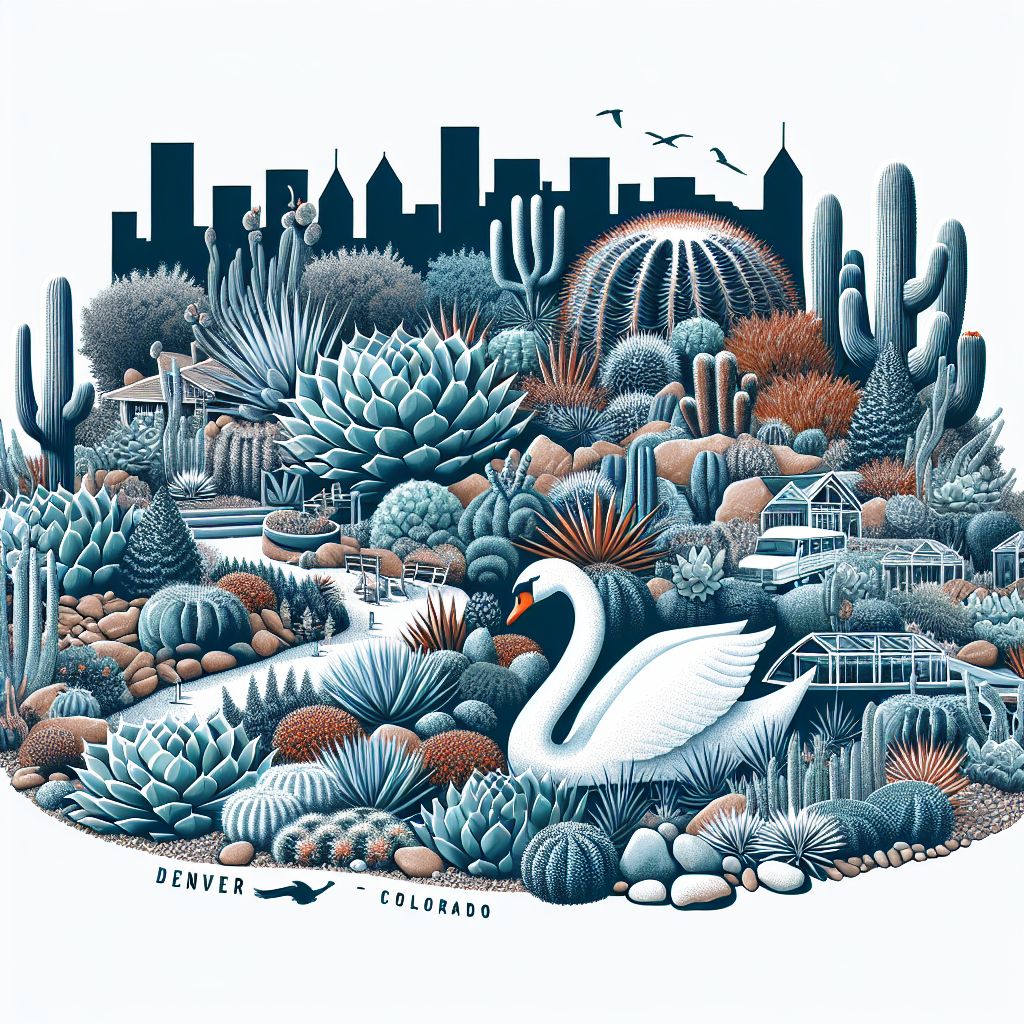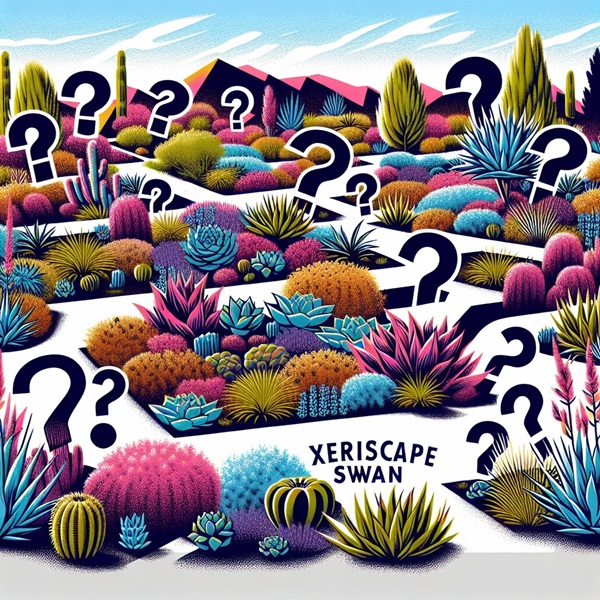
Key Takeaways
- Xeriscaping is a landscaping method that conserves water by utilizing drought-resistant plants.
- Denver’s semi-arid climate makes
a practical choice for homeowners. - Succulents and cacti are ideal for Denver xeriscapes, but there are many other plant options to consider.
- Designing a xeriscape garden can save money in the long run by reducing water and maintenance costs.
- Creative xeriscape design includes the use of rock features, local art, and strategic plant placement for year-round appeal.
Transforming Your Denver Yard: An Intro to Xeriscape
Imagine your outdoor space transformed into a stunning, low-water landscape that thrives in Denver’s climate and radiates beauty year-round. This isn’t just a dream; it’s xeriscaping, and it’s perfectly suited for the Mile High City. Let’s dive into creating a lush, water-wise garden that’s both easy on the eyes and the environment.
Xeriscape Explained: More Than Just Cacti
Xeriscaping isn’t about filling your yard with sand and cacti; it’s about making smart plant choices and designing a space that’s in harmony with the local environment. By selecting plants that are well-adapted to Denver’s conditions, you can create a landscape that’s vibrant and full of life, all while using less water.
Why Denver Climate Demands Smart Landscaping
Denver’s climate can be tricky for gardeners. With its low humidity, fluctuating temperatures, and occasional droughts, water conservation is key. Xeriscaping addresses these challenges head-on, ensuring your garden isn’t just surviving, but thriving. Besides that, it’s a responsible choice for our precious water resources.
And let’s not forget, Denver weather can throw us curveballs. A xeriscape garden is resilient, bouncing back from snow one day and basking in sunshine the next. That’s the kind of toughness you want in your backyard.
Choosing Your Xeriscape Components
Now, let’s talk plants. Choosing the right ones is like casting characters for a play – each has a role that contributes to the garden’s overall success. I’ll guide you through selecting the stars of your xeriscape, ensuring they’re ready for their Denver debut.
Succulents and Cacti: The Desert’s Best Friends
When you think of xeriscaping, succulents and cacti likely come to mind. These plants are the champions of water conservation, storing moisture in their leaves and stems for the dry days ahead. They come in all shapes and sizes, offering a variety of textures and colors for your garden palette.
Hardy Plants for a Denver Xeriscape
But our plant cast extends beyond these desert icons. There are many hardy plants that love the Colorado climate. These are the plants that will bring diversity and resilience to your xeriscape stage.
Grasses and Perennials: Xeriscape Supporting Actors
Grasses and perennials may not always take center stage, but they’re essential to the ensemble. They weave the garden together, providing movement and harmony.
Buffalo Grass and Blue Grama Grass: These native grasses are accustomed to the local climate, requiring minimal water once established. They’re the perfect backdrop, swaying gently in the Denver breeze.
Penstemon and Russian Sage: With their colorful blooms and attractive foliage, these perennials add depth to your garden narrative, drawing in pollinators and adding bursts of color.
Below is a data table featuring a selection of plants suitable for a Xeriscape design in Denver, CO, focusing on succulents and cacti. The table includes information on each plant’s watering needs, sunlight requirements, soil type, and mature size, based on the provided search results.
Table of Xeriscape Plants Denver
| Plant Name | Watering Needs | Sunlight Requirements | Soil Type | Mature Size |
|---|---|---|---|---|
| Echinocereus coccineus | Every 10 days[3] | Full sun[2] | Well-draining[2] | Varies; up to 12 in. |
| Hymenoxys acaulis | Sparingly, drought-tolerant[1] | Full sun[2] | Well-draining[2] | 1-2 in. tall, 4-6 in. wide |
| Escobaria sneedii | Every 10 days[3] | Full sun[2] | Well-draining[2] | 1-5 plants; size varies |
| Eriogonum ovalifolium | Sparingly, drought-tolerant[1] | Full sun to partial shade[4] | Well-draining[2] | 1-2 ft. tall and wide |
| Arenaria hookeri | Sparingly, drought-tolerant[1] | Full sun[2] | Well-draining[2] | Up to 3 in. tall |
References
- Denver/Front Range – Native Garden Designs – Wild Ones
- A Guide to Succulents and Cacti – Swansons Nursery
- How to Water Succulents and Cacti – Planet Desert
- The Beginner’s Guide to Xeriscaping In Denver – 5280 Magazine
A Plan for Costs and Savings
Embarking on a xeriscape transformation does require an upfront investment, but it’s important to look beyond the initial price tag. Over time, the savings on water bills and maintenance costs can be substantial. Let’s break it down, so you can see why your wallet will thank you later.
Initial Investment in Xeriscape Design
Initially, you’ll need to budget for the design, plants, and possibly hardscaping materials. Depending on the size of your yard and the complexity of your design, costs can vary. Generally, for a Denver xeriscape, you might expect:
- Design and Planning: Free if you DIY, or up to $500 if you hire a professional.
- Plants: Between $2 and $30 per plant, with a wide range due to the variety of options available.
- Materials: Mulch, rocks, and edging can run from $50 to $500, depending on your choices and the garden’s size.
- Labor: If you’re not going the DIY route, labor for installation can add $1,000 to $3,000 or more to your budget.
Therefore, while you might spend a bit upfront, these costs are an investment in a sustainable and beautiful future for your outdoor space.
Long-Term Financial Benefits of a Water-Wise Garden
The real savings come over time. With a xeriscape, you’ll see a reduction in your water bill – often by as much as 50% or more. Besides that, xeriscapes require less maintenance, which means fewer expenses for lawn care services and products.
Day-to-Day Xeriscape Care
One of the joys of xeriscaping is the reduced daily maintenance. No more constant mowing or fretting over thirsty plants. Your xeriscape is designed to be self-sufficient, thriving with minimal intervention.
Simplifying Your Garden’s Routine
After the initial establishment period, your xeriscape will need only occasional weeding and pruning. You’ll water less often, but when you do, do it deeply to encourage strong root growth. This simplicity is one of the xeriscape’s most attractive features.
Seasonal Maintenance Tips for a Lush Xeriscape
Even a low-maintenance garden like a xeriscape benefits from seasonal care. In spring, cut back any dead foliage and replenish mulch. Summer is the time to enjoy your garden’s full glory, with only occasional deadheading needed. Come fall, plant any new additions, and in winter, protect sensitive plants with burlap or additional mulch if needed.
Designing Your Desert Oasis
Designing a xeriscape is where your creativity shines. Think of your yard as a blank canvas ready to be filled with textures, colors, and shapes. I’ll walk you through some design principles that will help your garden stand out.
Creative Layouts for Xeriscape Gardens
Your layout should be both functional and beautiful. Start with a focal point – maybe a stunning agave or a sculptural yucca – and build around it. Group plants with similar water needs together, and use rocks and mulch to create paths and define spaces.
Rock Features and Pathways
Rocks aren’t just functional; they’re also an aesthetic element. Use them to create natural-looking borders or to build a dry riverbed for visual interest. Pathways not only guide visitors through your garden but also prevent soil compaction, helping water to penetrate the ground where it’s needed.
Creating Focal Points with Succulents
Succulents, with their unique forms and colors, make excellent focal points. A large barrel cactus or a group of brightly colored sedums can draw the eye and set the tone for your garden’s design. Remember, placement is key – you want these showstoppers to be seen. For more inspiration on using succulents in your xeriscape, explore these Xeriscape Plans provided by Denver Water.
Incorporating Local Art and Decor in Xeriscapes
Finally, add a personal touch with local art or decor. Whether it’s a hand-painted pot or a piece of metalwork from a Denver artisan, these elements tell your garden’s story. They’re the finishing touches that make your xeriscape uniquely yours.
Let’s Sum It Up
Transforming your Denver yard with xeriscape design is an adventure in creativity and sustainability. It’s about choosing the right plants, designing for your space, and enjoying the benefits of a garden that’s both beautiful and water-wise. With the right approach, you can create a stunning landscape that saves water, time, and money.
Xeriscape in Denver: A Smart, Stylish Choice
Choosing xeriscape for your Denver home isn’t just a smart environmental choice; it’s also a stylish one. With a variety of plants to choose from and endless possibilities for design, you can create an outdoor space that reflects your personality while respecting the local climate. Most importantly, xeriscape is an investment in the future of your home and our planet.
- Embrace the beauty and resilience of xeriscape plants that thrive in Denver’s climate.
- Design with creativity, incorporating local art and natural elements like rock features.
- Save on water bills and maintenance costs with a well-planned xeriscape garden.
- Enjoy the simplicity and reduced upkeep of your water-wise landscape.
- Boost your property’s value and curb appeal with a stylish xeriscape design.

Frequently Asked Questions (FAQ)
Can I Have a Lawn and Still Xeriscape?
Yes, you can! Xeriscaping isn’t about eliminating lawns; it’s about reducing water use. Opt for a smaller lawn area with drought-resistant grasses like Buffalo Grass or Blue Grama Grass, and complement it with other xeriscape elements.
How Do I Protect My Xeriscape from Wildlife?
- Choose plants that are less appealing to local wildlife or use protective barriers.
- Implement natural repellents like aromatic herbs that can deter animals.
- Design your layout with wildlife in mind, keeping more vulnerable plants closer to your home.
Remember, part of xeriscaping’s beauty is its ability to attract beneficial wildlife, adding to the ecosystem of your garden.
Is Xeriscape Only Suitable for New Properties?
Not at all! Xeriscaping can be incorporated into existing landscapes. You can start small, converting areas gradually, or revamp your entire yard. The principles of xeriscape are adaptable to any space, whether new or established.
What If My Xeriscape Plants Aren’t Thriving?
If your plants are struggling, assess their sunlight and water needs. Sometimes, simply relocating a plant or adjusting your watering schedule can make all the difference. Remember, the success of xeriscape plants often depends on proper establishment and care during the first year.



